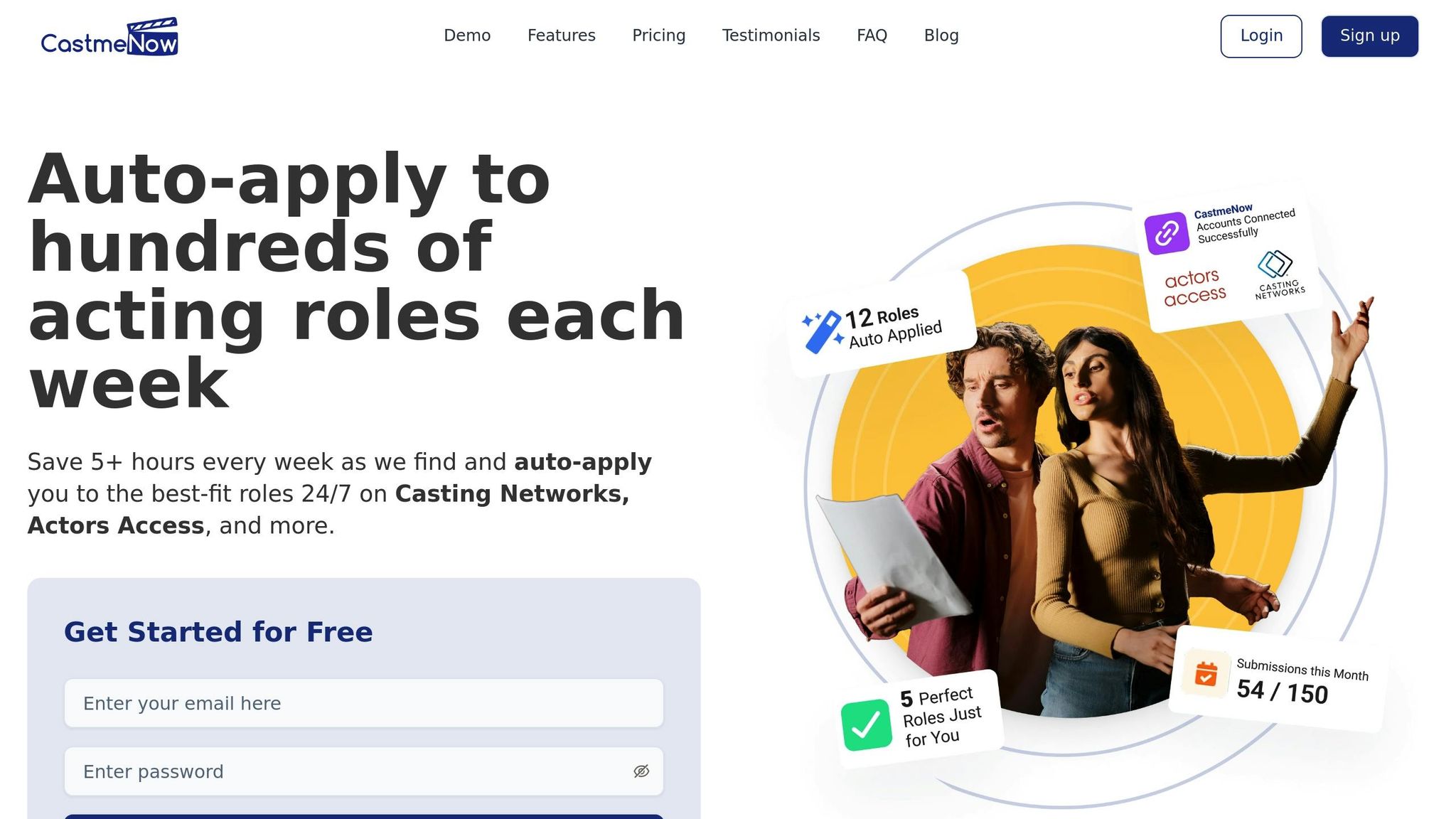Ultimate Guide to Audition Success Metrics
Learn how to track audition success metrics to enhance your acting career, improve performance, and make data-driven decisions.

Audition success metrics help actors track and improve their performance, turning guesswork into actionable insights. Here’s what you need to know:
-
Key Metrics to Track:
- Audition-to-Booking Ratio: How many auditions it takes to land a role. New actors may see 1:20 or 1:30; seasoned pros aim for 1:10 or better.
- Callback Conversion Rate: Percentage of auditions that lead to callbacks. A low rate means your initial audition needs work; a high rate with few bookings suggests refining final auditions.
- Role Type Success Rates: Track success by role type (comedy, drama, commercials) to identify strengths and gaps.
-
Tools for Tracking:
- Audition Logs: Record dates, role types, outcomes, and feedback to spot trends.
- Automation Tools: Platforms like CastmeNow streamline applications and track metrics automatically, saving time and boosting opportunities.
-
Why Metrics Matter:
- Identify areas for improvement, like audition techniques or self-tape quality.
- Make smarter financial decisions by calculating cost-per-audition and ROI.
- Set realistic short-term, mid-term, and long-term career goals.
Start tracking your metrics today to gain clarity, improve your skills, and make data-driven decisions for your acting career.
You DON'T Log Your Auditions? Here's what you're missing!
Key Metrics Every Actor Should Track
Knowing which metrics to monitor can bring clarity and direction to your acting career. Instead of navigating blindly through auditions and opportunities, tracking these numbers can help you identify strengths and areas for improvement. Below, we dive into some critical metrics that can shape your career strategy.
Audition-to-Booking Ratio
The audition-to-booking ratio measures how many auditions you attend compared to how many roles you land. It’s a reality check in an industry where rejection is common. For newer actors, especially in big cities, a ratio of 1:20 or 1:30 is pretty standard. More experienced actors might see ratios improve to 1:10 or 1:15, while A-list stars often boast ratios like 1:1 or 1:2. Talent agencies generally aim for their clients to book one role for every 15–25 auditions.
To calculate your ratio, divide the number of auditions by the roles you’ve booked. For example, if you’ve attended 40 auditions and booked 2 roles, your ratio is 1:20. This metric helps set realistic expectations and can highlight progress as your career develops.
Callback Conversion Rate
Your callback conversion rate shows how often your first auditions lead to callbacks. It’s calculated by dividing the number of callbacks you receive by your total auditions, then multiplying by 100 to get a percentage. For instance, if you’ve had 8 callbacks out of 50 auditions, your conversion rate is 16%.
A low callback rate might mean your initial auditions need work, while a high callback rate with few final bookings could point to issues with your follow-up auditions. Over time, tracking this metric can reveal whether your audition skills are improving and which types of roles tend to generate the most interest from casting directors.
Role Type Success Rates
Breaking down your success rates by role type can uncover your natural strengths and areas for growth. Track your audition-to-booking ratios and callback rates separately for categories like comedic roles, dramatic parts, voiceover gigs, and commercials. You might find you excel in one area while struggling in another, which could guide you toward targeted training or new opportunities.
For example, newer actors might need 50 to 100 auditions to book their first paid role. Those with more experience and frequent callbacks might land one role for every 20 to 50 auditions. Seasoned professionals often see booking rates closer to 1 in 10 auditions. By keeping detailed records of audition dates, role types, callback results, and bookings, you can identify patterns that inform your training and career strategy.
These metrics provide a solid foundation for refining your approach and exploring advanced tools to take your career to the next level.
Tools and Methods for Measuring Success
Tracking your audition metrics becomes much easier with the right tools. Research indicates that monitoring progress can boost success rates by 42%. By choosing methods that fit seamlessly into your workflow, you can uncover patterns that lead to actionable insights.
Using Audition Logs
Keeping an audition log is a straightforward yet powerful way to track your progress. This log acts as a detailed record of every audition, callback, and booking, helping you identify trends over time. It should include essential details such as the audition date, project type, casting director, role description, callback status, and final outcome. To add more context, consider noting preparation time, the audition format (in-person, self-tape, or virtual), and any feedback you receive. These extra details can help you spot why certain auditions perform better than others.
While a basic spreadsheet can do the job, there are specialized tools available that offer advanced tracking features, making the process even more effective.
Automation with CastmeNow

CastmeNow takes automation to the next level, streamlining your applications and tracking performance data. By integrating with your casting profiles on platforms like Casting Networks and Actors Access, it automatically applies to roles that match your preferences 24/7.
This automation allows you to focus on preparation and performance rather than the tedious task of finding roles. Kassan Harris, a CastmeNow user, shares:
"Instead of spending hours a day trying to find what I'm a good fit for; all my time is focused on prepping & submitting tapes as well as being in classes."
The platform's analytics underscore its effectiveness, showing notable improvements compared to manual submissions:
| Metric | Standard Method | With CastmeNow | Improvement |
|---|---|---|---|
| Submission Volume | Base reference | +300% | 4x increase |
| Callback Rate | Base reference | +25% | 1.25x increase |
| Weekly Time Investment | 10+ hours | 0–1 hours | 90%+ reduction |
Gabbi Mack highlights her success with the platform:
"LOVE CastMeNow so far! In just a week I've been submitted for over 80 projects and have received more EcoCasts than I have in months!"
CastmeNow also offers a free 30-day trial with no credit card required. After the trial, plans start at $3 per month for up to 10 daily applications or $8 per month for unlimited submissions. By analyzing which roles generate the most interest, you can refine your strategy and focus on the opportunities that matter most.
Tracking Costs and Return on Investment
Taking a closer look at the financial side of your auditions can help you make smarter decisions. Start by calculating your cost-per-audition: divide your monthly career expenses (like headshots, classes, platform fees, and transportation) by the number of auditions you attend. For instance, if you spend $400 a month and attend 20 auditions, your cost-per-audition is $20. With a booking rate of 1:15, each role costs about $300 in audition-related expenses. Comparing this to your average booking fee can give you a clearer picture of your return on investment.
Breaking your expenses into categories - such as training, marketing materials, or technology tools - can also help identify where your money is having the most impact. For example, if a $200 workshop results in a 10% increase in callbacks, that’s measurable progress. This financial perspective complements your performance metrics, giving you a well-rounded view of your career’s effectiveness.
Ian Mark, another CastmeNow user, emphasizes the platform’s time-saving benefits:
"Instead of spending an hour each day doing self-submits, CastMeNow has freed me up to spend that time doing more of what I really love - creating. I would absolutely recommend CMN to other actors who are tired of spending hours every week self submitting. CMN has saved me time and stress each day by automating my least favorite part of being an actor."
By combining financial insights with performance data, you can make informed decisions to optimize your career strategy.
(User testimonials are sourced from.)
Improving Performance with Metric Data
Tracking metrics like audition-to-booking ratios and callback rates is just the first step. The real value comes from analyzing this data to identify areas for improvement. By spotting patterns and making targeted adjustments, you can increase your chances of success. Start by diving into your callback data to uncover actionable insights.
Finding Patterns from Callback Data
Callback data can reveal a lot about your strengths and areas that need work. Look for trends in the types of roles you’re called back for, the timing of those callbacks, and recurring feedback from casting directors. For example, if you’re consistently getting callbacks for dramatic roles but not for comedic ones, it might highlight an area where additional training could help.
Pay attention to casting directors who repeatedly respond positively to your auditions. What made those auditions stand out? Was it your preparation, character interpretation, or even the technical quality of your self-tape? Understanding these elements can help you replicate what’s working.
Seasonal trends also play a role. Many actors notice an increase in callbacks during pilot season (January through April) or at times when specific types of projects are casting. By tracking these patterns, you can prepare for busier periods and manage your expectations during slower times. Once you’ve identified these trends, refine your approach through focused training and technical improvements.
Adjusting Training and Self-Tape Methods
Your metrics can guide you on where to focus your efforts, whether that’s improving your acting skills or tweaking your presentation. If callbacks are drying up after initial interest, it might be time to revisit your audition technique instead of solely focusing on marketing materials.
Technical upgrades are crucial for self-tape success. Poor lighting or audio can make it hard for casting directors to fully appreciate your performance. Use even lighting, a stable camera setup, and a plain background to keep the focus on you. Frame your shot from the chest up and test your audio quality before recording.
Performance tweaks can often make the biggest difference. Actress and instructor Kearsten Johansson reminds actors:
"This is where you're going to have to become your own director".
Making bold character choices and creating a believable environment can help your performance resonate with viewers. Memorizing your lines is another way to enhance your self-tape. As John Tench, an instructor at Toronto Film School, puts it:
"Your script is your best friend".
If you hold the script, do so in a way that allows for natural eye contact and reactions.
Metrics can also help pinpoint specific areas for improvement. Low callback rates might signal the need for acting workshops, while challenges in converting callbacks into bookings could suggest working on confidence and resilience. Seeking feedback from industry professionals can also help uncover blind spots in your technique.
Setting Realistic Goals
Use your data to set achievable, metrics-based goals that align with your career timeline.
| Goal Type | Metrics to Track | Review |
|---|---|---|
| Short-term | Audition count, callback rate | Weekly |
| Mid-term | Booking ratio, skill development | Monthly |
| Long-term | Career progression, income growth | Quarterly |
Short-term goals should focus on immediate improvements, like increasing your callback rate by a small percentage over the next month. If your current callback rate is 8%, aim for a modest bump rather than an unrealistic leap.
Mid-term goals are about refining your skills and improving your booking ratio. A three-month period gives you enough time to implement changes and see results.
Long-term goals should reflect your broader career ambitions. Use your historical booking data to set realistic income targets and track your progress over time. Acting careers are naturally unpredictable, so avoid overreacting to short-term fluctuations. Instead, rely on consistent measurement to guide your strategy.
Metrics can also signal when it’s time to invest in your career. If you’re sending out plenty of auditions but not getting callbacks, it might be worth investing in coaching or refreshing your headshots. On the other hand, if you’re landing callbacks but struggling to book roles, refining your audition technique could make the difference. These benchmarks ensure that every adjustment you make is building on your progress.
Conclusion: Taking Control of Your Acting Career
Keeping tabs on your audition success metrics is like having a personalized roadmap for your career. It shows you where to channel your time, energy, and resources to make the biggest impact.
Data beats guesswork. Studies show that people tracking their progress are 42% more likely to hit their goals. This principle applies directly to acting. For instance, if you notice higher callback rates for specific roles, you can refine your training and focus your auditions accordingly. This kind of insight ensures your efforts are targeted, not scattered.
Metrics also reveal patterns you might otherwise miss. Maybe your booking rate spikes during pilot season, or certain casting directors consistently call you back. With this knowledge, you can prioritize the opportunities most aligned with your strengths instead of spreading yourself thin by applying for every role that pops up.
Automation makes tracking easier. Tools like CastmeNow simplify the process, handling 24/7 submissions so you can spend less time scrolling through casting boards and more time honing your craft.
Long-term planning is just as important as short-term wins. Your career timeline matters. Industry stats show only 2% of actors make a living from acting, and 69% of acting careers last just one year. These numbers emphasize why strategy is crucial. Metrics help you determine whether you're building momentum or just riding a wave of chance.
Interestingly, the early years of an acting career often hold the most promise. That’s why starting early with good tracking habits can make all the difference, giving you the tools to maximize opportunities when they matter most.
Solid data supports smart financial decisions. By tracking your booking ratios and estimating potential income, you can set realistic financial goals. Whether it’s investing in new headshots, coaching sessions, or better equipment, your data will tell you when to scale up or adjust your approach.
The key is consistency. Start logging auditions, define the metrics that matter most to you, and track everything - whether manually or with automation tools. This disciplined approach transforms random submissions into meaningful, career-building opportunities.
Actors who succeed treat their careers like a business. They measure performance, analyze results, and adapt strategically. Your audition metrics are the backbone of this business mindset, offering the clarity and direction needed to build a sustainable acting career.
FAQs
What are the best ways to improve my audition-to-booking ratio as a beginner actor?
Improving your audition-to-booking ratio as a beginner actor boils down to three main areas: creating more opportunities, focusing on the right roles, and sharpening your skills.
- Create more opportunities: Get yourself out there by attending as many auditions as you can. Network with industry professionals, collaborate with your agent, and make the most of casting platforms to find roles that suit your profile. More auditions mean more chances to land a role.
- Focus on the right roles: Make sure your headshots, résumé, and demo reel showcase what makes you stand out. Highlighting your strengths helps you get noticed for roles that are a natural fit. Being intentional about auditioning for roles that match your type and abilities can significantly boost your chances.
- Sharpen your skills: Think of auditioning as a craft. Take acting classes, practice consistently, and prepare thoroughly for each opportunity. Confidence, preparation, and a polished performance can leave a strong impression on casting directors.
Success in acting doesn’t happen overnight, but with persistence and preparation, you’ll improve your odds in this competitive industry!
How can actors use audition logs to track and improve their performance?
Keeping audition logs is a smart way for actors to track their progress and fine-tune their skills. Start by recording key details for every audition - things like the casting office, project name, audition date, and outcomes, such as callbacks or bookings. These records can help you identify patterns in your performance and pinpoint areas where you might want to improve.
But don’t just log the information and forget about it. Make it a habit to review your notes regularly. Reflect on any feedback you received, how you felt during the audition, and any observations you jotted down. This process can give you valuable insights to help you prepare more effectively for future auditions, especially callbacks or similar roles. Staying organized and learning from past experiences is a powerful way to sharpen your audition game.
How can financial metrics help actors make smarter career choices?
Financial Metrics for Actors: A Tool for Smarter Career Choices
Understanding financial metrics can be a game-changer for actors looking to make better career decisions. For instance, knowing that the average hourly earnings for actors in 2023 is about $20.50 provides a baseline for setting realistic income goals. On the flip side, keeping track of expenses like headshots, acting classes, and agent fees is essential for effective budgeting.
When you break down these numbers, it becomes easier to evaluate whether investments in training or promotional materials are paying off. This kind of analysis helps you decide which roles or opportunities align with your financial and career goals. With this knowledge, you can allocate your resources more effectively, negotiate stronger pay rates, and ultimately work toward building a stable and thriving career in the entertainment industry.

